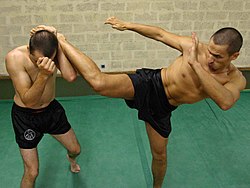Roundhouse kick
| Roundhouse kick | |||||||
 |
|||||||
| Korean name | |||||||
|---|---|---|---|---|---|---|---|
| Hangul | 돌려 차기 | ||||||
|
|||||||
| Japanese name | |||||||
| Kanji | 回し蹴り | ||||||
| Hiragana | まわしげり | ||||||
|
|||||||
| Transcriptions | |
|---|---|
| Revised Romanization | dollyeo chagi |
| McCune–Reischauer | tollyŏ ch'aki |
| Transcriptions | |
|---|---|
| Revised Hepburn | mawashi-geri |
| Kunrei-shiki | mawasi-geri |
A roundhouse kick (also known as swinging kick or a power angle kick but often confused with the round kick) is a kick in which the attacker swings his or her leg around in a semicircular motion, striking with the front of the leg or foot. This type of kick is utilized in many different martial arts and is popular in both non-contact and full-contact martial arts competitions. The kick has many variations based on stance, leg movement, striking surface, and the height of the kick.
A semi-circular kick is a round kick to forty five degree roundhouse kick (or "diagonal kick"). Most popular in kick-boxing, lethwei, and muay Thai, it can be used in almost every situation. With this kick, all parts of the opponent’s body can be attacked and every kind of attack can be countered.
Low kick outside
Low kick inside
Middle kick
Low kick in counter
Karate has many different methods of delivering their roundhouse kick (mawashi geri). The original method involved bringing up the knee, and then swiftly turning the hip over and snapping the leg outwards from the knee to deliver a strike with the ball of the foot. The ball of the foot was believed to be more effective and less dangerous than other methods.
As the years have gone by, some karate schools also practice kicking roundhouse kick with the shin, another point of contact is with the instep (for safety).
There are now more and more karateka practicing the 'cutting roundhouse kick'; this is where the karateka will lift their attacking leg higher than the intended target, they will then execute the kick in a downward cutting movement. Practitioners consider it a very effective method against the thigh.
This was later supplemented in Masutatsu Oyama's Kyokushin karate with a similar technique, using the instep and using more rotation of the hip, as well as sinking the weight of the kicker into the target, to create more bludgeoning power. The target of this kick was primarily the neck. Oyama also taught roundhouse kicks to the thigh and ribs, using the shin as the point of contact.
Middle-kick with rotation of the hips and body in the direction of the kick
Middle-kick in counterattack
...
Wikipedia
